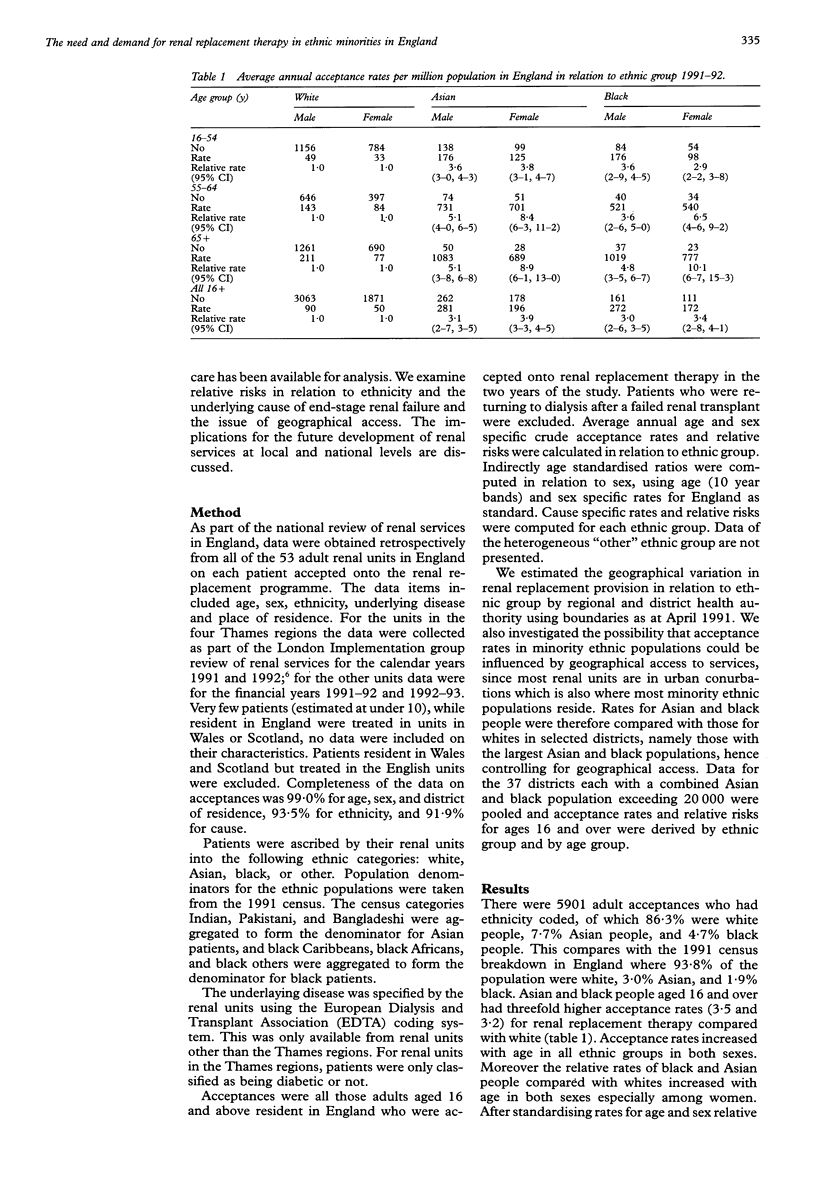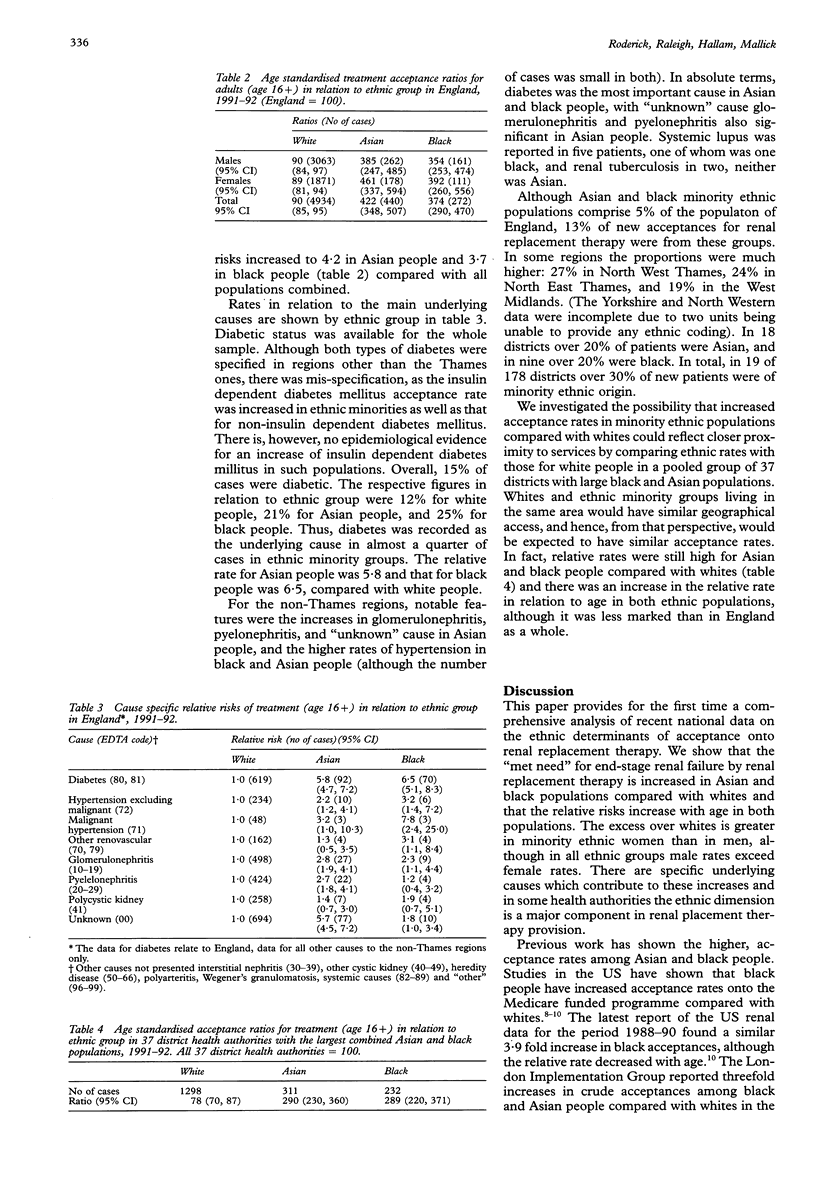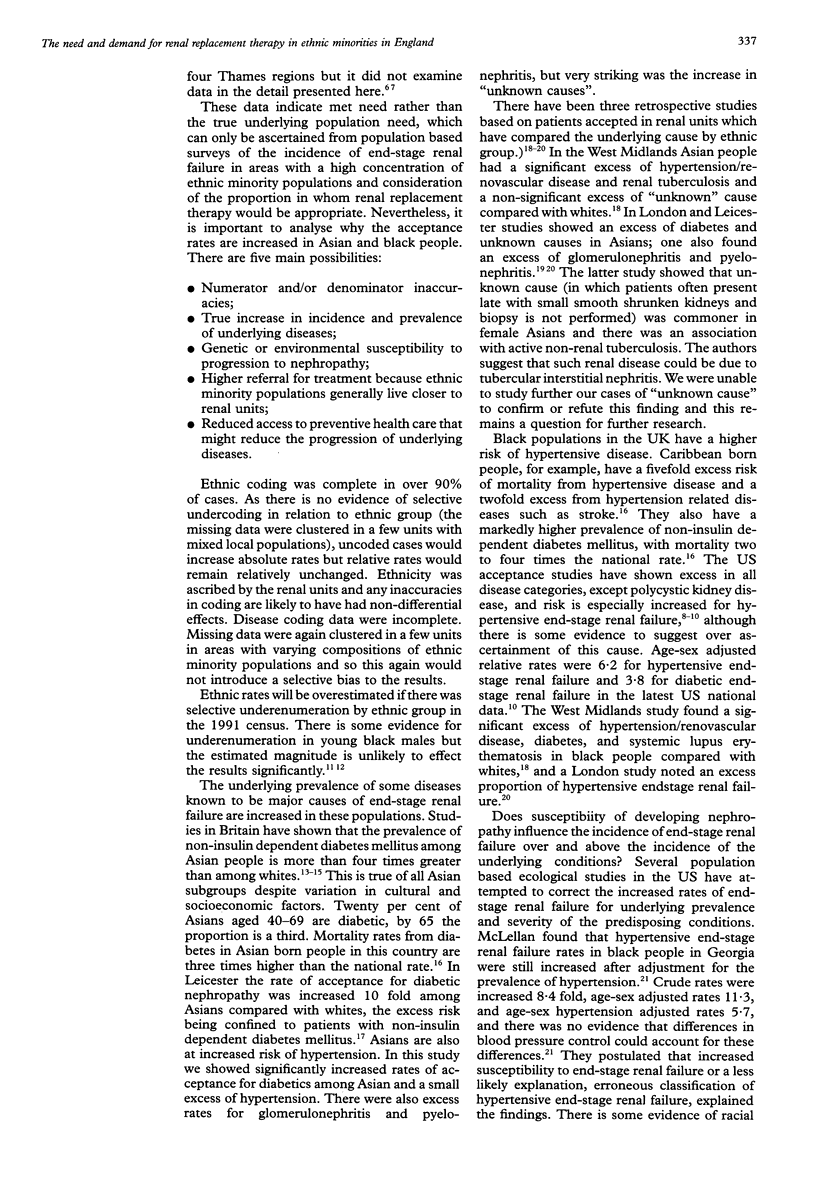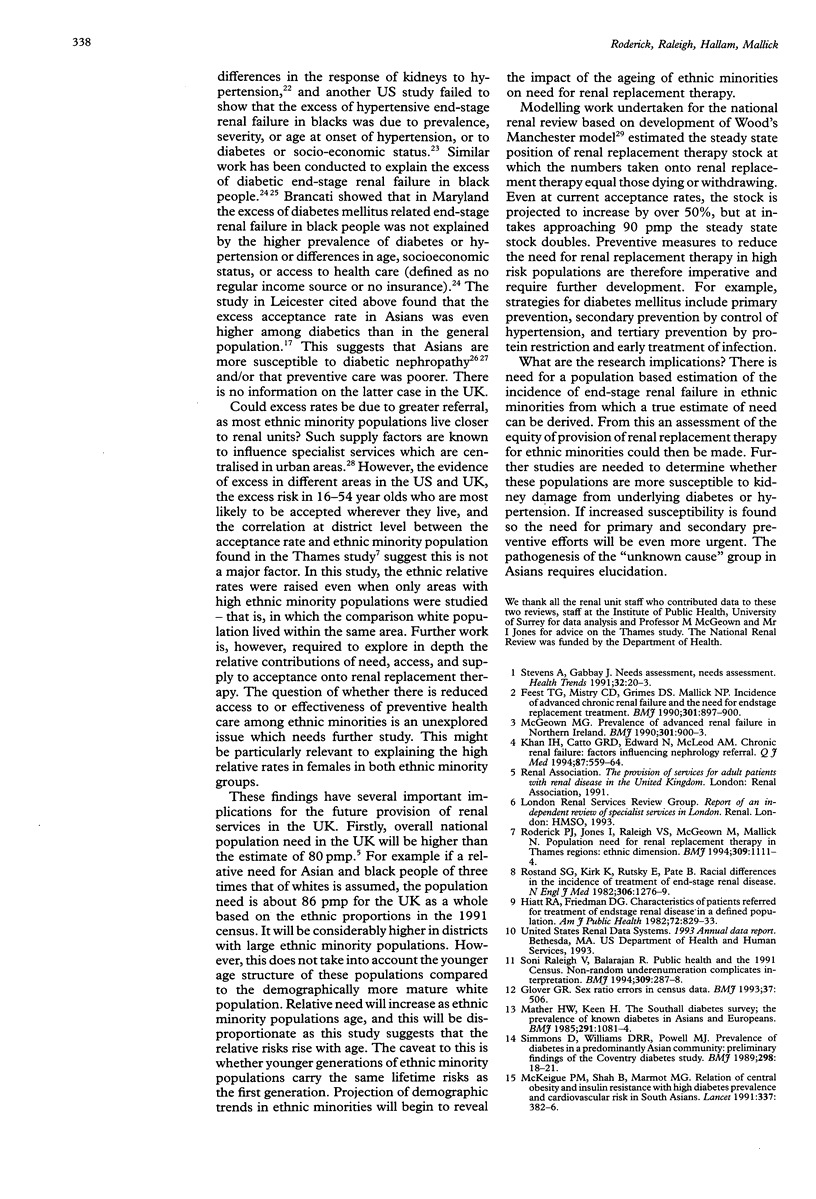Abstract
STUDY OBJECTIVE: The study aimed to determine the relative risk of being accepted for renal replacement treatment of black and Asian populations compared with whites in relation to age, sex, and underlying cause. The implications for population need for renal replacement therapy in these populations and for the development of renal services were also considered. DESIGN/SETTING: This was a cross sectional retrospective survey of all patients accepted for renal replacement treatment in renal units in England in 1991 and 1992. PATIENTS: These comprised all 5901 patients resident in England with end-stage renal failure who had been accepted for renal replacement therapy in renal units in England and whose ethnic category was available from the units. Patients were categorised as white, Asian, black, or other. Population denominators for the ethnic populations were taken from the 1991 census. The census categories Indian, Pakistani, and Bangladeshi were aggregated to form the denominator for Asian patients, and black Caribbeans, black Africans, and black others were aggregated to form the denominator for black patients. MAIN RESULT: Altogether 7.7% of patients accepted were Asian and 4.7% were black; crude relative acceptance rates compared with whites were 3.5 and 3.2 respectively. Age sex specific relative acceptance ratios increased with age in both ethnic populations and were greater in females. Age standardised acceptance ratios were increased 4.2 and 3.7 times in Asian and black people respectively. The most common underlaying cause in both these populations was diabetes; relative rates of acceptance for diabetic end-stage renal failure were 5.8 and 6.5 respectively. The European Dialysis and Transplant Association coding system was inaccurate for disaggregating non-insulin and insulin dependent forms. "Unknown causes" were an important category in Asians with a relative acceptance of rate 5.7. The relative rates were reduced only slightly when the comparison was confined to the district health authorities with large ethnic minority populations, suggesting that geographical access was not a major factor in the high rates for ethnic minorities. CONCLUSION: Acceptance rates for renal replacement treatment are increased significantly in Asian and black populations. Although data inaccuracies and access factors may contribute to these findings, the main reason is probably the higher incidence of end-stage renal failure. This in turn is due to the greater prevalence of underlying diseases such as non-insulin dependent diabetes but possibly also increased susceptibility of developing nethropathy. The main implication is that these populations age demand for renal replacement treatment will increase. This will have an impact nationally but will be particularly apparent in areas with large ethnic minority populations. Future planning must take these factors into account and should include strategies for preventing chronic renal failure, especially that due to non-insulin dependent diabetes and hypertension. The data could not determine the extent to which population need was being met; further studies are required to estimate the incidence of end-stage renal failure in ethnic minority populations.
Full text
PDF





Selected References
These references are in PubMed. This may not be the complete list of references from this article.
- Allawi J., Rao P. V., Gilbert R., Scott G., Jarrett R. J., Keen H., Viberti G. C., Mather H. M. Microalbuminuria in non-insulin-dependent diabetes: its prevalence in Indian compared with Europid patients. Br Med J (Clin Res Ed) 1988 Feb 13;296(6620):462–464. doi: 10.1136/bmj.296.6620.462. [DOI] [PMC free article] [PubMed] [Google Scholar]
- Brancati F. L., Whittle J. C., Whelton P. K., Seidler A. J., Klag M. J. The excess incidence of diabetic end-stage renal disease among blacks. A population-based study of potential explanatory factors. JAMA. 1992 Dec 2;268(21):3079–3084. [PubMed] [Google Scholar]
- Burden A. C., McNally P. G., Feehally J., Walls J. Increased incidence of end-stage renal failure secondary to diabetes mellitus in Asian ethnic groups in the United Kingdom. Diabet Med. 1992 Aug-Sep;9(7):641–645. doi: 10.1111/j.1464-5491.1992.tb01860.x. [DOI] [PubMed] [Google Scholar]
- Clark T. J., Richards N. T., Adu D., Michael J. Increased prevalence of dialysis-dependent renal failure in ethnic minorities in the west Midlands. Nephrol Dial Transplant. 1993;8(2):146–148. [PubMed] [Google Scholar]
- Cowie C. C., Port F. K., Wolfe R. A., Savage P. J., Moll P. P., Hawthorne V. M. Disparities in incidence of diabetic end-stage renal disease according to race and type of diabetes. N Engl J Med. 1989 Oct 19;321(16):1074–1079. doi: 10.1056/NEJM198910193211603. [DOI] [PubMed] [Google Scholar]
- Dalziel M., Garrett C. Intraregional variation in treatment of end stage renal failure. Br Med J (Clin Res Ed) 1987 May 30;294(6584):1382–1383. doi: 10.1136/bmj.294.6584.1382. [DOI] [PMC free article] [PubMed] [Google Scholar]
- Feest T. G., Mistry C. D., Grimes D. S., Mallick N. P. Incidence of advanced chronic renal failure and the need for end stage renal replacement treatment. BMJ. 1990 Oct 20;301(6757):897–900. doi: 10.1136/bmj.301.6757.897. [DOI] [PMC free article] [PubMed] [Google Scholar]
- Glover G. R. Sex ratio errors in census data. BMJ. 1993 Aug 21;307(6902):506–506. doi: 10.1136/bmj.307.6902.506-a. [DOI] [PMC free article] [PubMed] [Google Scholar]
- Hiatt R. A., Friedman G. D. Characteristics of patients referred for treatment of end-stage renal disease in a defined population. Am J Public Health. 1982 Aug;72(8):829–833. doi: 10.2105/ajph.72.8.829. [DOI] [PMC free article] [PubMed] [Google Scholar]
- Khan I. H., Catto G. R., Edward N., MacLeod A. M. Chronic renal failure: factors influencing nephrology referral. QJM. 1994 Sep;87(9):559–564. [PubMed] [Google Scholar]
- Mather H. M., Keen H. The Southall Diabetes Survey: prevalence of known diabetes in Asians and Europeans. Br Med J (Clin Res Ed) 1985 Oct 19;291(6502):1081–1084. doi: 10.1136/bmj.291.6502.1081. [DOI] [PMC free article] [PubMed] [Google Scholar]
- McClellan W., Tuttle E., Issa A. Racial differences in the incidence of hypertensive end-stage renal disease (ESRD) are not entirely explained by differences in the prevalence of hypertension. Am J Kidney Dis. 1988 Oct;12(4):285–290. doi: 10.1016/s0272-6386(88)80221-x. [DOI] [PubMed] [Google Scholar]
- McGeown M. G. Prevalence of advanced renal failure in Northern Ireland. BMJ. 1990 Oct 20;301(6757):900–903. doi: 10.1136/bmj.301.6757.900. [DOI] [PMC free article] [PubMed] [Google Scholar]
- McKeigue P. M., Shah B., Marmot M. G. Relation of central obesity and insulin resistance with high diabetes prevalence and cardiovascular risk in South Asians. Lancet. 1991 Feb 16;337(8738):382–386. doi: 10.1016/0140-6736(91)91164-p. [DOI] [PubMed] [Google Scholar]
- Pazianas M., Eastwood J. B., MacRae K. D., Phillips M. E. Racial origin and primary renal diagnosis in 771 patients with end-stage renal disease. Nephrol Dial Transplant. 1991;6(12):931–935. doi: 10.1093/ndt/6.12.931. [DOI] [PubMed] [Google Scholar]
- Raleigh V. S., Balarajan R. Public health and the 1991 census. BMJ. 1994 Jul 30;309(6950):287–288. doi: 10.1136/bmj.309.6950.287. [DOI] [PMC free article] [PubMed] [Google Scholar]
- Roderick P. J., Jones I., Raleigh V. S., McGeown M., Mallick N. Population need for renal replacement therapy in Thames regions: ethnic dimension. BMJ. 1994 Oct 29;309(6962):1111–1114. doi: 10.1136/bmj.309.6962.1111. [DOI] [PMC free article] [PubMed] [Google Scholar]
- Rostand S. G., Kirk K. A., Rutsky E. A., Pate B. A. Racial differences in the incidence of treatment for end-stage renal disease. N Engl J Med. 1982 May 27;306(21):1276–1279. doi: 10.1056/NEJM198205273062106. [DOI] [PubMed] [Google Scholar]
- Samanta A., Burden A. C., Feehally J., Walls J. Diabetic renal disease: differences between Asian and white patients. Br Med J (Clin Res Ed) 1986 Aug 9;293(6543):366–367. doi: 10.1136/bmj.293.6543.366-a. [DOI] [PMC free article] [PubMed] [Google Scholar]
- Simmons D., Williams D. R., Powell M. J. Prevalence of diabetes in a predominantly Asian community: preliminary findings of the Coventry diabetes study. BMJ. 1989 Jan 7;298(6665):18–21. doi: 10.1136/bmj.298.6665.18. [DOI] [PMC free article] [PubMed] [Google Scholar]
- Stevens A., Gabbay J. Needs assessment needs assessment.... Health Trends. 1991;23(1):20–23. [PubMed] [Google Scholar]
- Whittle J. C., Whelton P. K., Seidler A. J., Klag M. J. Does racial variation in risk factors explain black-white differences in the incidence of hypertensive end-stage renal disease? Arch Intern Med. 1991 Jul;151(7):1359–1364. [PubMed] [Google Scholar]
- Wood I. T., Mallick N. P., Wing A. J. Prediction of resources needed to achieve the national target for treatment of renal failure. Br Med J (Clin Res Ed) 1987 Jun 6;294(6585):1467–1470. doi: 10.1136/bmj.294.6585.1467. [DOI] [PMC free article] [PubMed] [Google Scholar]


